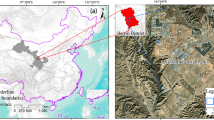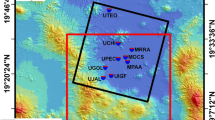Abstract
Ground deformation (GD) has been widely reported as a global issue and is now an ongoing problem that will profoundly endanger the public safety. GD is a complex and dynamic problem with many contributing factors that occur over time. In the literature, there are only a few methods that can effectively monitor GD. Microwave remote sensing data such as interferometric synthetic aperture radar (InSAR) are mostly adopted to assess GD. These data can reveal the surface deforming areas with great precision, mapping GD results at a large scale. In this study, the effects of GD and the influencing factors, such as the building area, the water level, the cumulative precipitation, and the cumulative temperature, are modeled in the Erhai region with small baseline subset interferometric SAR (SBAS-InSAR) data that are applied using machine learning (ML) methods. The ML methods, namely, multiple linear regression (MLR), multilayer perceptron backpropagation (MLP-BP), least squares support vector machine (LSSVM), and particle swarm optimization (PSO)-LSSVM, are used to predict GD, and the results are compared. Particularly, the PSO-LSSVM method has obtained the least root mean square error (RMSE) and mean relative error (MRE) of 11.448 and 0.112, respectively. Therefore, the results have proven that the proposed PSO-LSSVM is very efficient in analyzing GD.











Similar content being viewed by others
Change history
16 July 2020
Unfortunately, the name of the corresponding author (Wenxiang Wu) was missing in the author group section of the published paper.
References
Aburas, M. M., Ahamad, M. S. S., & Omar, N. Q. (2019). Spatio-temporal simulation and prediction of land-use change using conventional and machine learning models: a review. Environmental Monitoring and Assessment, 191(4), 205.
Ahmadi, M.-A., & Bahadori, A. (2015). A LSSVM approach for determining well placement and conning phenomena in horizontal wells. Fuel, 153, 276–283.
Asmau, A., Olga, D., Yahya, Z., & Mike, S. (2017). Hybrid spectral unmixing: using artificial neural networks for linear/non-linear switching. Remote Sensing, 9(8), 775.
Bijan, R., Hamid, A., Mahyar, Y., & Oliver, K. (2019). Particle swarm optimization algorithm for Neuro-fuzzy prospectivity analysis using continuously weighted spatial exploration data. Natural Resources Research, 28(2), 309–325.
Mahabir, C., Hicks, F. E., Robichaud, C., & Robinson Fayek, A. (2006). Forecasting breakup water levels at Fort McMurray, Alberta, using multiple linear regression. Canadian Journal of Civil Engineering, 33(9), 1227–1238(1212).
Chen, Y., Tan, K., Yan, S., Zhang, K., Zhang, H., Liu, X., Li, H., & Sun, Y. (2019). Monitoring land surface displacement over Xuzhou (China) in 2015–2018 through PCA-based correction applied to SAR interferometry. Remote Sensing, 11(12), 1494.
Del Soldato, M., Solari, L., Poggi, F., Raspini, F., Tomás, R., Fanti, R., & Casagli, N. (2019). Landslide-induced damage probability estimation coupling InSAR and field survey data by fragility curves. Remote Sensing, 11(12), 1486.
Deo, R. C., & Şahin, M. (2016). An extreme learning machine model for the simulation of monthly mean streamflow water level in eastern Queensland. Environmental Monitoring and Assessment, 188(2), 90.
Du, L., Shuo, S., Jian, Y., Jia, S., & Wei, G. (2016). Using different regression methods to estimate leaf nitrogen content in rice by fusing Hyperspectral LiDAR data and laser-induced chlorophyll fluorescence data. Remote Sensing, 8(6), 526.
Eberhart, R., & Kennedy, J. A. (2002). New optimizer using particle swarm theory. In: Mhs95 Sixth International Symposium on Micro Machine & Human Science.
Eberly, L. E. (2007). Multiple linear regression. Methods in Molecular Biology, 404(2), 165.
Fioribello, S., & Giribone, P. G. (2019). Design of an artificial neural network battery for an optimal recognition of patterns in financial time series. International Journal of Financial Engineering.
Forman, B. A., & Reichle, R. H. (2017). Using a support vector machine and a land surface model to estimate large-scale passive microwave brightness temperatures over snow-covered land in North America. IEEE Journal of Selected Topics in Applied Earth Observations & Remote Sensing, 8(9), 4431–4441.
Gandhi, A. S., D'Souza, S., & Arjun, N. B. (2018). Prediction of daily sea surface temperature using artificial neural networks., 39(12).
Gao, M., Gong, H., Li, X., Chen, B., Zhou, C., Shi, M., Guo, L., Chen, Z., Ni, Z., & Duan, G. (2019). Land subsidence and ground fissures in Beijing capital international airport (BCIA): Evidence from quasi-PS InSAR analysis. Remote Sensing, 11(12), 1466.
Ghaemi, Z., Alimohammadi, A., & Farnaghi, M. (2018). LaSVM-based big data learning system for dynamic prediction of air pollution in Tehran. Environmental Monitoring and Assessment, 190(5), 300.
Hakkarinen, C., & Smith, J. B. (2006). Climate change scenarios. Chapters, Climate Change Scenarios.
Hsu, K. L., Gupta, H. V., & Sorooshian, S. (1995). Artificial neural network modeling of the rainfall-runoff process. Water Resources Research, 31(31), 2517–2530.
Ishaque, K., Salam, Z., Amjad, M., & Mekhilef, S. (2012). An improved particle swarm optimization (PSO)–based MPPT for PV with reduced steady-state oscillation. IEEE Transactions on Power Electronics, 27(8), 3627–3638.
Jiang, L., Bai, L., Zhao, Y., Cao, G., Wang, H., & Sun, Q. (2018). Combining InSAR and hydraulic head measurements to estimate aquifer parameters and storage variations of confined aquifer system in Cangzhou, North China plain. Water Resources Research, 54(10), 8234–8252. https://doi.org/10.1029/2017wr022126.
Kai, J., Jiang, W., Jing, L., & Tang, Z. (2018). Spectral matching based on discrete particle swarm optimization: a new method for terrestrial water body extraction using multi-temporal Landsat 8 images. Remote Sensing of Environment, 209, 1–18.
Kim, J. W., Lu, Z., Jia, Y., & Shum, C. K. (2015). Ground subsidence in Tucson, Arizona, monitored by time-series analysis using multi-sensor InSAR datasets from 1993 to 2011. ISPRS Journal of Photogrammetry & Remote Sensing, 107, 126–141.
Liu, G. Z. (2009). Convergence analysis of standard particle swarm optimization algorithm. Science Technology & Engineering, 24(1), 187–194.
Liu, H., Su, H., & Bo, Z. (2018). Hyperspectral multiple features optimization using improved firefly algorithm. Remote Sensing Technology & Application, 33(1).
Liu, Q., Yang, M., Lei, J., Jin, H., Gao, Z., & Wang, Y. (2012). Modeling and optimizing parabolic trough solar collector systems using the least squares support vector machine method. Solar Energy, 86(7), 1973–1980.
Lu, N., Wang, W., Zhang, Q., Li, D., Yao, X., Tian, Y., Zhu, Y., Cao, W., Baret, F., Liu, S., & Cheng, T. (2019). Estimation of nitrogen nutrition status in winter wheat from unmanned aerial vehicle based multi-angular multispectral imagery. Frontiers in Plant Science, 10. https://doi.org/10.3389/fpls.2019.01601.
Ma, G., Zhao, Q., Wang, Q., & Liu, M. (2018). On the effects of InSAR temporal decorrelation and its implications for land cover classification: the case of the ocean-reclaimed lands of the Shanghai megacity. Sensors, 18(9), 2939.
Naghibi, S. A., Pourghasemi, H. R., & Dixon, B. (2016). GIS-based groundwater potential mapping using boosted regression tree, classification and regression tree, and random forest machine learning models in Iran. Environmental Monitoring and Assessment, 188(1), 44.
Nikos, S., Ioannis, P., Constantinos, L., Paraskevas, T., Anastasia, K., & Charalambos, K. (2016). Land subsidence rebound detected via multi-temporal InSAR and ground truth data in Kalochori and Sindos regions, northern Greece. Engineering Geology, 209, 175–186.
Puliyalil, H., Cvelbar, U., Filipi, G., Petri, A. D., Zaplotnik, R., Recek, N., Mozeti, M., & Thomas, S. (2015). Plasma as a tool for enhancing insulation properties of polymer composites. RSC Advances, 5(47), 37853–37858.
Schwieder, M., Leitao, P. J., Süß, S., Senf, C., & Hostert, P. (2014). Estimating fractional shrub cover using simulated EnMAP data: a comparison of three machine learning regression techniques. Remote Sensing, 6(4), 3427–3445.
SOMA, A. S., KUBOTA, T., & MIZUNO, H. (2019). Optimization of causative factors using logistic regression and artificial neural network models for landslide susceptibility assessment in Ujung Loe watershed, South Sulawesi Indonesia. Journal of Mountain Science, 16(02), 144–162.
Suykens, J. A. K., & Vandewalle, J. (1999). Least squares support vector machine classifiers. Neural Processing Letters, 9(3), 293–300.
Szantoi, Z., Escobedo, F. J., Abd-Elrahman, A., Pearlstine, L., Dewitt, B., & Smith, S. (2015). Classifying spatially heterogeneous wetland communities using machine learning algorithms and spectral and textural features. Environmental Monitoring and Assessment, 187(5), 262.
Vapnik, V. (1995). The nature of statistical learning theory.
Wang, H., Wright, T. J., Yu, Y., Lin, H., Jiang, L., Li, C., & Qiu, G. (2012). InSAR reveals coastal subsidence in the Pearl River Delta, China. Geophysical Journal International, 191(3), 1119–1128. https://doi.org/10.1111/j.1365-246X.2012.05687.x.
Wang, L., Liu, D., Wang, Q., & Ying, W. (2013). Spectral unmixing model based on least squares support vector machine with unmixing residue constraints. IEEE Geoscience & Remote Sensing Letters, 10(6), 1592–1596.
Wang, P., Tian, J. W., & Gao, C. Q. (2009). Infrared small target detection using directional highpass filters based on LS-SVM. Electronics Letters, 45(3), 156.
Wang, Y., Guo, Y., Hu, S., Li, Y., Wang, J., Liu, X., & Wang, L. (2019). Ground deformation analysis using InSAR and backpropagation prediction with influencing factors in Erhai region, China. Sustainability, 11(10), 2853.
Wu, D., Lary, D. J., Zewdie, G. K., & Liu, X. (2019). Using machine learning to understand the temporal morphology of the PM 2.5 annual cycle in East Asia. Environmental Monitoring and Assessment, 191(2), 272.
Xu, M., Liangpei, Z., Bo, D., Lefei, Z., Yanguo, F., & Dongmei, S. (2017). A mutation operator accelerated quantum-behaved particle swarm optimization algorithm for Hyperspectral Endmember extraction. Remote Sensing, 9(3), 197.
Yang, S., Feng, Q., Liang, T., Liu, B., Zhang, W., & Xie, H. (2017). Modeling grassland above-ground biomass based on artificial neural network and remote sensing in the Three-River headwaters region. Remote Sensing of Environment, 204.
Yang, Z. P., Lu, W. X., Long, Y. Q., & Li, P. (2009). Application and comparison of two prediction models for groundwater levels: a case study in Western Jilin Province, China. Journal of Arid Environments, 73(4), 487–492.
Yashar, R., & Farshid, F. A. (2018). Application of InSAR in measuring Earth’s surface deformation caused by groundwater extraction and modeling its behavior using time series analysis by artificial neural networks. Acta Geophysica, 66(5), 1171–1184.
Zewdie, G. K., Lary, D. J., Liu, X., Wu, D., & Levetin, E. (2019). Estimating the daily pollen concentration in the atmosphere using machine learning and NEXRAD weather radar data. Environmental Monitoring and Assessment, 191(7), 418.
Zhao, R., Z-w, L., G-c, F., & Wang Q-j, H. J. (2016). Monitoring surface deformation over permafrost with an improved SBAS-InSAR algorithm: with emphasis on climatic factors modeling. Remote Sensing of Environment, 184, 276–287.
Zhou, C., Gong, H., Zhang, Y., Warner, T. A., & Wang, C. (2018). Spatiotemporal evolution of land subsidence in the Beijing plain 2003–2015 using persistent Scatterer interferometry (PSI) with multi-source SAR data. Remote Sensing, 10(4), 552.
Zhu, B., Li, J., Chu, Z., Tang, W., Wang, B., & Li, D. (2016). A robust and multi-weighted approach to estimating topographically correlated tropospheric delays in radar interferograms. Sensors, 16(7), 1078.
Funding
This research was funded by the Strategic Priority Research Program of the Chinese Academy of Sciences (XDA19040101, XDA19040304).
Author information
Authors and Affiliations
Contributions
For research articles with several authors, a short paragraph specifying their individual contributions must be provided. The following statements should be used “conceptualization, YH.G.; methodology, YH.G., J.S., WX.W.; software, SQ.H., WX.W.; validation, YH.G.; formal analysis, YH.G.; investigation, YH.G., WX.W.; resources, YH.G.; data curation, YH.G.; writing—original draft preparation, YH.G.; writing—review and editing, YH.G., J.S; visualization, YH.G.; supervision, YH.G.; funding acquisition, YH.G., YY.W., please turn to the CRediT taxonomy for the term explanation. Authorship must be limited to those who have contributed substantially to the work reported.
Corresponding author
Ethics declarations
Conflict of interest
The authors declare no conflict of interest.
Additional information
Publisher’s note
Springer Nature remains neutral with regard to jurisdictional claims in published maps and institutional affiliations.
Rights and permissions
About this article
Cite this article
Guo, Y., Hu, S., Wu, W. et al. Multitemporal time series analysis using machine learning models for ground deformation in the Erhai region, China. Environ Monit Assess 192, 464 (2020). https://doi.org/10.1007/s10661-020-08426-8
Received:
Accepted:
Published:
DOI: https://doi.org/10.1007/s10661-020-08426-8




